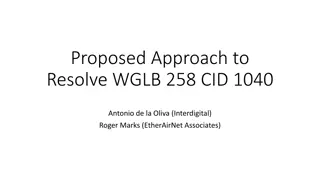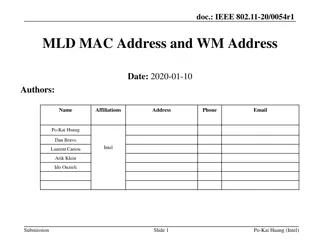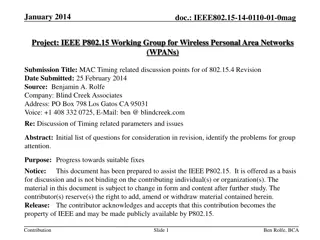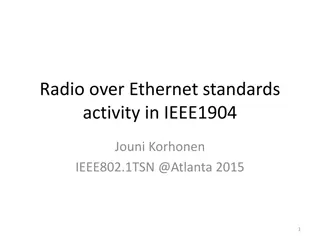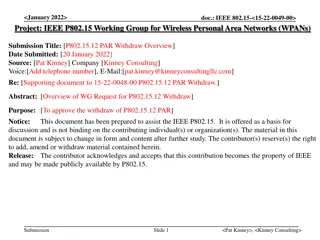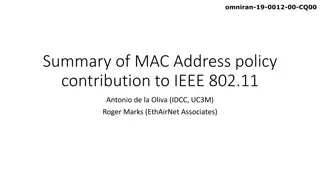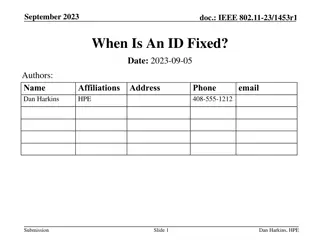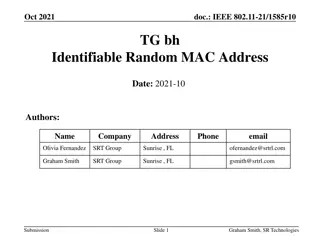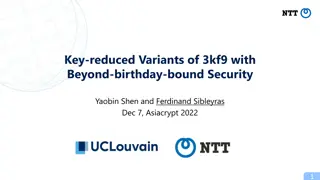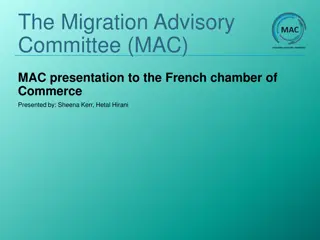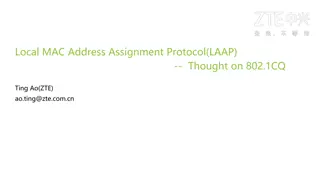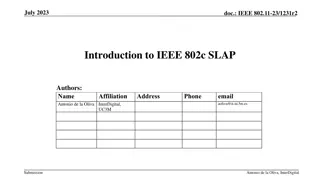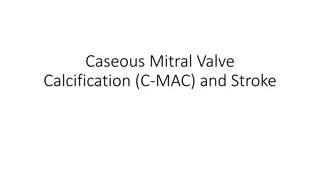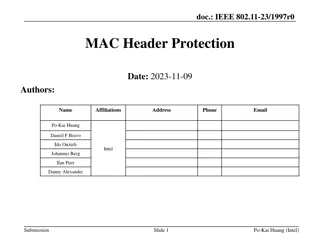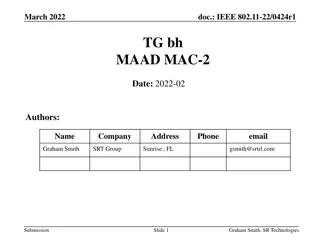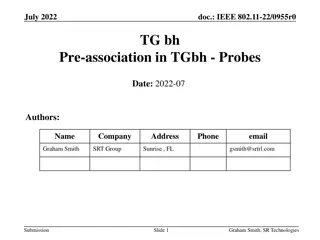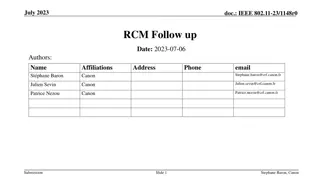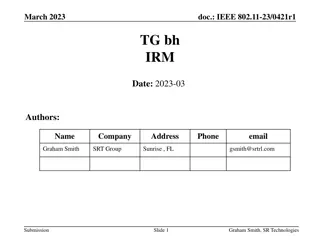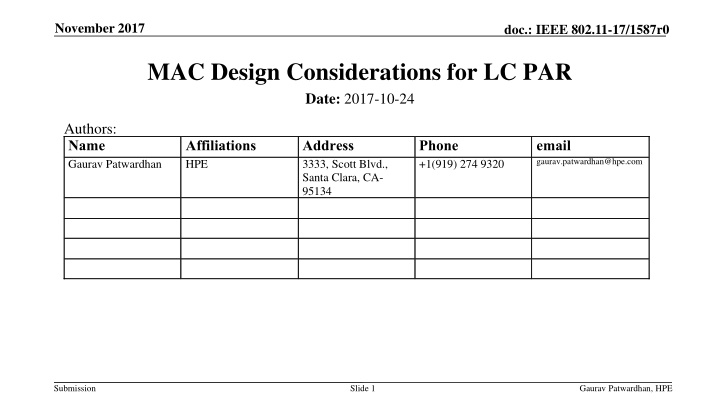
IEEE 802.11-17/1587r0 MAC Layer Design Considerations
"Explore MAC layer design considerations for preparing PAR and CSD for LC SG in IEEE 802.11-17/1587r0, covering topics like channel access, contention mechanisms, full duplex access challenges, and half duplex channel complexities."
Download Presentation

Please find below an Image/Link to download the presentation.
The content on the website is provided AS IS for your information and personal use only. It may not be sold, licensed, or shared on other websites without obtaining consent from the author. If you encounter any issues during the download, it is possible that the publisher has removed the file from their server.
You are allowed to download the files provided on this website for personal or commercial use, subject to the condition that they are used lawfully. All files are the property of their respective owners.
The content on the website is provided AS IS for your information and personal use only. It may not be sold, licensed, or shared on other websites without obtaining consent from the author.
E N D
Presentation Transcript
November 2017 doc.: IEEE 802.11-17/1587r0 MAC Design Considerations for LC PAR Date: 2017-10-24 Authors: Name Gaurav Patwardhan Affiliations HPE Address 3333, Scott Blvd., Santa Clara, CA- 95134 Phone +1(919) 274 9320 email gaurav.patwardhan@hpe.com Submission Slide 1 Gaurav Patwardhan, HPE
November 2017 doc.: IEEE 802.11-17/1587r0 Abstract Provides a high level overview of MAC layer design considerations for preparing PAR and CSD for LC SG. Lower MAC Channel Access and Contention. Upper MAC Aggregation and Fragmentation, QoS, Security services (Authentication, Encryption, Integrity). Other design considerations. Conclusion. Submission Slide 2 Gaurav Patwardhan, HPE
November 2017 doc.: IEEE 802.11-17/1587r0 Channel Access and Contention Channel access and contention mechanisms are broadly classified into two types: Mechanisms for Full duplex communication channel. With VLC DL and RF UL With VLC DL and IR UL Mechanisms for Half duplex communication channel. With VLC DL and VLC UL Submission Slide 3 Gaurav Patwardhan, HPE
November 2017 doc.: IEEE 802.11-17/1587r0 Full Duplex Access (with VLC DL and RF UL) Complicates the MAC layer in 802.11-2016 [1] since the atomic operation of RTS-> CTS-> Data -> ACK is split over two separate channels. For DL Data, ACK is UL and sent on RF, i.e. subjected to the CSMA/CA of that RF channel with existing 802.11 APs and STAs. Need the LC AP to have a CTS-to-self mechanism on the RF channel to reserve the medium. Requires co-ordination across timers in LC and RF for proper NAV. Inherently asymmetric transmit ranges of the AP and the STA (due to LOS/NLOS and transmit range differences). Submission Slide 4 Gaurav Patwardhan, HPE
November 2017 doc.: IEEE 802.11-17/1587r0 Full Duplex Access (with VLC DL and IR UL) DL and UL frequency ranges are closer, thus packets with similar size take same time on the medium thus increasing MAC efficiency w.r.t. VLC DL and RF UL. Will require more hardware filters (and more cost) to separate the UL and DL traffic to minimize self-interference. Cannot work in NLOS conditions. Can interfere with existing devices like IR based security cameras. Submission Slide 5 Gaurav Patwardhan, HPE
November 2017 doc.: IEEE 802.11-17/1587r0 Half Duplex channel (VLC DL and VLC UL) Can use existing CSMA/CA mechanisms from 802.11. Channel capacity is split into two due to the half duplex nature of the medium. Can reuse a hybrid version of the MAC layer access from 802.11ad [2]. Very difficult to integrate Mesh topologies. STAs will have VLC emitters and hence will have glare. Submission Slide 6 Gaurav Patwardhan, HPE
November 2017 doc.: IEEE 802.11-17/1587r0 Aggregation and Fragmentation For LC, MPDU and MSDU Aggregation s core mechanism from 802.11- 2016 [1] need not be changed since it only defines the aggregated size of the PDU which LLC sublayer entity exchanges with its peer. The maximum number of MPDUs which can be aggregated can be amended for LC in the 802.11 standard. Fragmentation can be an issue if a VLC DL and RF UL type channel access is used due to the ACKs required on the UL. Submission Slide 7 Gaurav Patwardhan, HPE
November 2017 doc.: IEEE 802.11-17/1587r0 QoS The MAC in 802.11 provides QoS using TID to specify differentiated service and is done on a per MSDU basis. The PDU given by LLC to the MAC can have TID specified using 802.1p (for example) and can be queued to the proper queue for QoS by the MAC. Thus the QoS mechanism is not really affected by changing the PHY to LC. Only the packet scheduler and timers need to updated (implementation issue, not 802.11). Submission Slide 8 Gaurav Patwardhan, HPE
November 2017 doc.: IEEE 802.11-17/1587r0 Security services 802.11 specifies CCMP and GCMP mechanisms for providing Confidentiality, Authentication and Access Control (when used with higher layer 802.1x protocol). Since LC is a medium with much higher bandwidth when compared to existing 802.11-2016[1], a faster encryption suite is required. For LC, the existing GCMP encryption from 802.11-2016 [1] security services specified in the MAC can be reused. Submission Slide 9 Gaurav Patwardhan, HPE
November 2017 doc.: IEEE 802.11-17/1587r0 Other design considerations Power Save With Half Duplex implementation existing 802.11-2016 can be used. With Full Duplex implementation, amendments to the 802.11-2106 standard are required. Mesh topology More discussions required to cover all aspects. Ex: For hybrid LC/RF mesh points, With LC only STAs, etc. IBSS topology Need to consider channel access medium methods when designing for an ad-hoc IBSS topology. Submission Slide 10 Gaurav Patwardhan, HPE
November 2017 doc.: IEEE 802.11-17/1587r0 Conclusion (1/2) Need more discussions on the lower MAC i.e. Channel Access and Contention. Upper MAC (Aggregation, QoS, security etc.) can remain largely unchanged. Other considerations as type of topologies supported need to be revisited/amended in the current 802.11 standard. Submission Slide 11 Gaurav Patwardhan, HPE
November 2017 doc.: IEEE 802.11-17/1587r0 Conclusion (2/2) Transparent FST infrastructure [Fig. 4-23][1] fits perfectly with some changes and can be considered as a template going forward. Submission Slide 12 Gaurav Patwardhan, HPE
November 2017 doc.: IEEE 802.11-17/1587r0 References [1] IEEE 802.11 2016 rev (http://ieeexplore.ieee.org/servlet/opac?punumber=7786993) [2] IEEE 802.11ad-2012 (http://ieeexplore.ieee.org/servlet/opac?punumber=6392840 ) [3] Challenges and Solutions for Networking in the Millimeter-Wave Band (people.kth.se/~carlofi/Tutorials/IEEE-ICT16/mm-wave_tutorial_Joerg.pdf) Submission Slide 13 Gaurav Patwardhan, HPE

